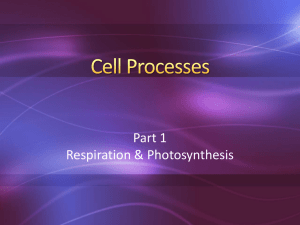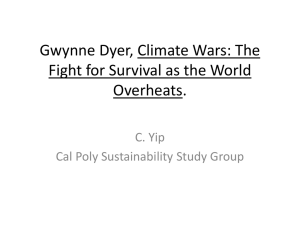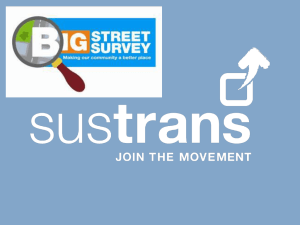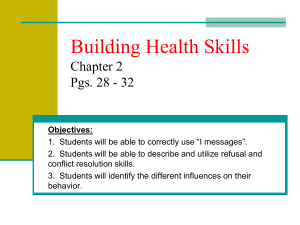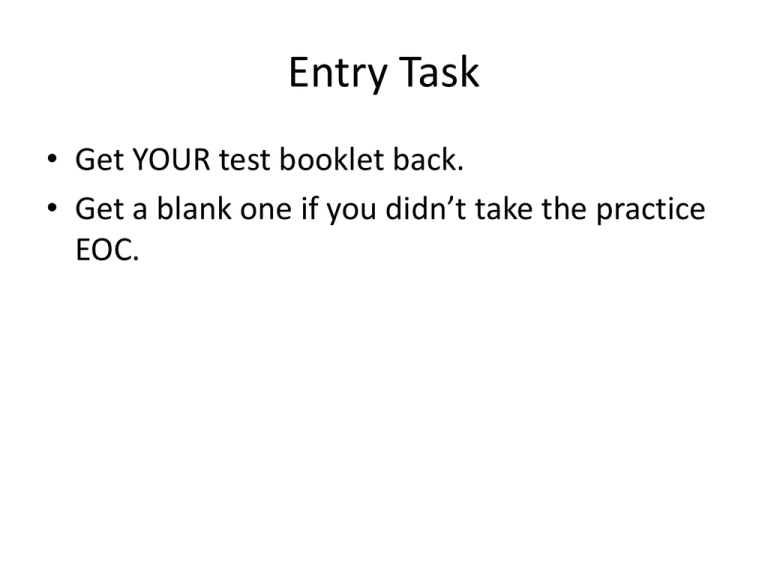
Entry Task
• Get YOUR test booklet back.
• Get a blank one if you didn’t take the practice
EOC.
Calendar
• Today: Review EOC Practice Book, finish
Greensburg, KS Video.
• Tuesday 5/21: Review 10th Grade material for
EOC.
• Tuesday, 5/28: Review 9th Grade material for
EOC.
• Thurs 5/30, Mon 6/3 & Wed 6/5 – EOC for first
half of each class.
(CH 16 project stuff on 2nd half).
Included here are a series of questions used on previous Biology
EOCs. They have been “retired” for use as sample “practice” questions.
It is important to keep in mind this is NOT about memorizing
the answers to these questions (wouldn’t do you any good if
you did since they’re retired) but rather…
--get a “feel” for the format
--consider the topics (what biological concepts are
they addressing?)
--for the extended-response questions, it often isn’t
as much biological concept as it may be a
scientific approach to problem solving
Hope you find this useful…(feedback is welcome!!)
Hint…use the up/down arrow keys to navigate this power pt.
Question #1 is about: feedback loops.
Goal: Systems (cause & effect).
There are two types of feedback: positive & negative.
Let’s say Action A is something you do – play Xbox, do homework, talk to friends.
If you get positive (reinforcing) feedback, are you more or less likely to keep
doing it? What about negative feedback?
If body temp goes up, your sweat levels go up. Does this make it more or less
likely that your body temperature rises further?
Let’s look at an example from a previous lab…
As you may (or may not) recall, you dropped alka seltzer tablets into a couple
test tubes (CH 11, Carbon Lab #3) which generated CO2 gas. That gas
can easily turn right around and react with the water in the test tube
forming carbonic acid. Your results showed the acid-tube generated
more gas (finger height) than the water-tube (red arrow). That means
the now-acidic-tube will generate an even GREATER amount of gas…
which will, in turn, react with the solution making it even more acidic
which will, of course,ANSWER
generate even greater quantities of CO2 . Like a
vicious circle…a
snowball
rolling
Sweating
is your
body’s attempt to lower body temperature.
gathering
Asdownhill,
the amt of
sweat INCREASES,Abody
temp DECREASES
POSITIVE
ever-greater
amounts
This is your body’s
attempt toFEEDBACK
re-achieve BALANCE
of snow!
LOOP
A balancing loop…NEGATIVE FEEDBACK
An example of a negative?
Consider your iTunes library
and an iTunes gift card. As you
increase the # of songs in your
library, the amount on the
card is reduced. As your $$ goes
down and down, the size
of your library grows….& grows.
Here’s another example of a FEEDBACK LOOP-type question…
NEGATIVE (“balancing loop”) = as A increases B decreases
(or vice versa)
Choice C…adding insulin increases the amt of glucose…would be a reinforcing loop
or POSITIVE feedback…only choice…
…D… “balances” high levels of one by decreasing the other
Question #2 addresses your knowledge of the major chemical cycles on earth.
There’s the WATER cycle, the CARBON cycle, the OXYGEN cycle, and the NITROGEN
cycle (to name a few). Considering the fact that nearly 80% of earth’s atmosphere
is NITROGEN, yet exists in a form NOT USABLE by most life forms, and yet is a
fundamental element in ALL life forms (it’s the reason amino acids are literally
called AMINO!!), this is a question assessing whether or not you’ve learned of
the existence of (and dependence of life on) what are called “nitrogen-fixing”
bacteria (like those commonly found in root nodules of pea plants).
The next four Questions #3-6 are an example of scenario-based questions. While
You can obviously approach these by whatever means suits you best, many folks
that are uniquely-successful find the following technique most productive…
--skip over the scenario
--go straight to the questions
--read each question so you get an idea of the specific kinds of things they are
looking for (allows for a more “focused” read of the scenario)
--go back and read the scenario, keeping the questions in mind
…as you can see, questions 3 and 5 (the two multiple choice questions) really
have NOTHING to do with the scenario!! They are there to assess
your knowledge of experimental design
…questions #4 & #6 are extended response items which will take a little
explaining. Now, skip to the answers…
Let’s tackle 3 & 5 first…
RE
RE
Even if you totally forgot that
liability involves
peated trials*, look closer
at the options. Choices A, C, and D ALL involve CHANGES (“other acidities”, “increase
the volume”, and “use a different”)…only B keeps all conditions…
*the same.
Question 5 involves good ol…
There are several ways to increase the validity of an experimental design. In
addition to a Peer Review, running an experimental control group, and having
LOTS of controlled variables, only choice D is a step that will reduce the impact
of human error/variance.
Choices B & C both involve RELIABILITY (multiple trials) and choice A…really?
Here’s another past-EOC question of similar style, but tied to a scenario about taking
a survey of salmonberry plants in/around a forest. The field study involves sampling
3 types of habitat using three 5-by-5m plots .
Like another Controlled Variable
No impact whatsoever
Smaller!? plots…nope
4 instead of 3? More reliable
An example of a 2-pt, extended response question is Question #4: Write a Conclusion
Best advice here…DOUBLE CHECK to make CERTAIN you answered EVERY BULLET!!!
Lucky for you, as a Tahoma sophomore, you are already quite familiar with the
first 2 bullets… “According to the data the hypothesis is…” AND BACK IT UP WITH
DATA!!!!
Let’s examine each bullet…
The prediction was supported by the data, as the pH
IMPORTANT: INcreased, the amt of foam also INcreased…to a point. The
Use AVERAGES AVERAGE amt of foam increased from 24ml to 35ml between
pH 6 and 7 then another 7ml between pH 7 & 8 BUT THEN it
if possible &
dropped an AVERAGE of 12ml between pH 8 and 9.
include both
Enzyme function is impacted by pH. In the case of
MAX & MIN
catalase, it appears to function best (judging by maximum foam
(range)
production) in a mild base (pH 8). It’s effectiveness drops
sharply in acidic solutions (below 7.0) and again in bases
stronger than 8.0 Acids impair the function of catalase
(destroy its chemical structure) as do strong bases. Potato
cells must have a slightly basic pH.
Question 6 is another 2-point extended response item: design a follow-up experiment
Again…PAY ATTENTION TO THE BULLETS!!!
In this example, rather than pH (MV) vs amt of foam (RV) you are tasked with a
Manipulated Variable (MV) of…
…and a responding variable (RV) of…
Let’s take a look at several possible responses…
…I don’t know where to start …the bullets?
0 controlled variables, 1 MV but only two “levels” (hot?
and unheated?), 1 RV (but how do you???), ignored
the last bullet, and this is not “logical” because no one
could repeat these steps with reliable results
SCORE = ZERO
Better…but still…
2 controlled variables (steps 1 & 3)
1 MV and three “levels” (34, rm temp, and 89)
1 RV (but again how do you measure “bubble data”?)
Again, the last bullet is ignored, no repeated trials
and this is not “logical enough”
SCORE = ONE PT
SCORE = ONE PT
Getting better…
Only 1 controlled variable (1 drop of peroxide)
1 MV and three (weak) “levels” (fridge, rm, m-wave?)
1 RV …FINALLY!, something measurable, the last bullet
is included, AND repeated trials! But measurements
not recorded. However, steps ARE logical enough…
SCORE =
TWO PTs
2 controlled variables (steps 1, 2, & 3)
1 MV, 3 evenly-spaced “levels” (72, 82, and 92)
1 RV and last bullet (Step 4), enough detail to be
logical, reliable, and even a “validity measure” (using
SAME thermometer)
Here’s a few more “stand-alone” type questions…
Release? NO…consume? yep
Respiration yes but…not burning gasoline
Photosynthesis??
Respiration and fossil fuels…can you say “CH 11!!!?” ...hmmmm….respiration…
…glucose + oxygen carbon dioxide + water…in order to generate energy (in
the form of ATP)
and burning fossil fuels…hmmmm….
…carbon compound (fossil fuels) + oxygen(burning) carbon dioxide + water
Again…this isn’t about memorizing answers…it’s about getting a feel for both the style
as well as the “topics” (which you should feel good about)
or
ANY
species
As you can see, genetics figures prominently…these concepts were from “CH 7”…
Above…while mutation can increase genetic variation, the EPIC generator of diversity has
always been SEX (mixing of genes to get new/unique combinations)
And below…this is remembering the difference between MEIosis and MITosis. MEIosis is all
about GAMETES (pollen/ova) and would have HALF (the diploid #) or 7.
Since it’s about a non-reproductive structure (a leaf) and it’s MITOSIS (like cloning) you’d say
Unsure why they specified “nonnative” plants…read it this way…
That’d be a neat trick
Huh? Glucose, not ash
You should IMMEDIATELY recognize (throw out) choice D… evolution-by-intent* is one
of those GROSS misunderstandings among people that “don’t get evolution.”
*something mutates to get what it wants/needs
From CH 14…a “niche”…a collection of factors that define the living space of a species
After a forest fire a lot of previously-claimed living space is suddenly “up for grabs”
(whether you’re a native species or not!)
Speaking of habitats…
As you’ve been learning in CH 16, “There are no such things as PERFECT solutions…there
are ALWAYS unintended consequences.”
In this question, “adding butterfly habitat” (structures providing biotic/abiotic needs for
butterflies) can mean many things, none of which (that I can see) would impact either
B or D of an entire ecosystem! Along those same lines would lie choice A…how would
adding say, a netting?, remove nutrients? (caterpillars need trees but adding trees won’t
REMOVE nutrients) But Choice C…
Whatever structure is added, no matter how small or seemingly insignificant, WILL
introduce something “new.”
None of these multiple choice questions require knowledge of the scenario. They are
simply items designed to measure your grasp of biology concepts. Take a look at #7…
…if you recall your concepts from CH 8 (transcription & translation), this should an easy
one. DNARNAamino acidsPROTEIN!! “How do plants…?” Actually, how does
ANY living thing…?
B is bogus as the primary thing plants get from soil is WATER (not proteins!)
C sounds like something from a Harry Potter novel, “MAGIC THAT IS!!”
D …there ARE proteins in seeds but not enough to grow an entire plant! It
would be a violation of the conservation of matter, for Pete’s sake!
EDITORIAL COMMENT: I can see why this one was retired…it’s vague, at best. But you can
still learn something from it…
PURPOSE: To increase the garden’s food mass
Applying logic to the biology…
Choice A : Even if you discovered the answer, how would you be able to use the
knowledge to increase food mass? Force-feed the plants more carbon???
Choice C : The purpose wasn’t to grow high-protein plants but simply more mass
Choice D : Large seeds do NOT mean more plant mass
Choice B : This knowledge could be applied to the entire garden and in most cases
result in better crop yields (it’s WHY we “fertilize” our gardens)
After everything you learned in CH 11, this one’s a breeze…
Choices A, B, and D are all part of the PHOTOSYNTHETIC process…NOT respiration
If you weren’t aware, “ATP” or *AdenosineTriPhosphate, is the primary “ENERGY
molecule” employed by living things…produced in the MITOCHONDRIA of cells,
the same way CHLOROPLASTS of plant cells are in charge of photosynthesis.
And you learned about ATP in 9th grade.
Another (2-pt) extended response item…which seems to focus on RELIABILITY
RELIABLE means REPEATED TRIALS…a REPEATED trial only counts as truly REPEATED if…
…EVERYTHING REMAINS THE SAME as it is run again. What aspects of a greenhouse
make it UNRELIABLE?
Let’s try the skip-ahead-and-read-the-questions technique
…here, read these, THEN look at the scenario on the
next slide (which, in the test format, came BEFORE
the questions)
At first this seems like a question you’d see on a READING HSPE…yet it involves concepts
you learned in CH 6 (natural selection/evolution).
After reading the scenario you learned 84% of the finches died because their
beaks were unable to access the remaining food following the 1977 drought.
Only finches with bigger beaks (16%) survived…eventually dominating the finch
population (“medium ground finch”, that is).
It had nothing to do with lack of water (A) or emigration (C) and Choice B…
…as we’ve learned, evolution isn’t a choice for a species …survival-of-the-fittest means
POPULATIONS EVOLVE!!!
Frankly, this question can be answered WITHOUT READING THE SCENARIO. It is
simply a species-interaction question (CH 14).
There are errors here… “a new bird species” ? We know nothing about it. If anything
the word “would” should be changed to COULD…
D : predation by the new bird is a possibility but it would DECREASE the finch pop
A : if finches reproduce they wouldn’t DEcline, if a new bird occupies finch breeding
grounds, finches WOULD decline (vague choice)
B : also vague…with a new bird on the island the finch might have an adaptation that
allows it to survive better than the new bird but why wait for a new bird?
…ummmmm….a math question? OK….whatever….
720 finches / 80 acres =
NINE
Skip-ahead-and-read-the-questions technique again…
…here, read these, THEN look at the scenario on the
next slide (which, in the test format, came BEFORE
the questions)
Again, scenario-not-required…this one’s from the concepts in CH 7 (genetics)
Choosing between A and B, B might be correct IF you were talking about GAMETES
…but you’re not.
So glad I read the scenario because THIS question…oh, wait…never mind.
Cell’s liquid environment
Builds proteins/hormones/enzymes out of amino acids
Contains DNA
This question covers CELL STRUCTURE & FUNCTION…an area THS Inquiry is weak on.
Technically, it is part of the 9th grade Inquiry program but memories get fuzzy…
Mitochondria are the energy-producers of cells, “burning” glucose (by respiration) to
build ATP molecules…producing carbon dioxide in the process. Plants complete the
Carbon Cycle with the chloroplast, using the CO2 + water to produce oxygen + glucose
which is what the mitochondria use, the oxygen to burn the glucose…and so on…
FINALLY…a scenario-based quest---NOT….oh well…
Carbon Labs, CH 11, Station 6: Plants
“What are plants made of?”
“THIN AIR!!!!”
2 PT
question
ZERO PTS
ONE PT
TWO PTS
Let’s look at a few more scenarioindependent questions…
Remember
this one?
Glucose & oxygen are
bear INPUTS
water’s an OUTPUT but not
needed-for-respiration
A scenario-independent question… (as in, “who cares about the scenario?”)
After all, what do think plants make all that
Bear “output”?? Oh. On a molecular level.
glucose out of in the first place!?
Being heterotrophic, bears only undergo cellular respiration (unlike plants which,
being autotrophic, BOTH respire AND photosynthesize)…so…
(BEAR) RESPIRATION:
INPUTS
OUTPUTS
glucose + oxygen carbon dioxide + water
(SALMONBERRY)
PHOTOSYNTHESIS:
INPUTS (used)
OUTPUTS
carbon dioxide + water glucose + oxygen
Above, another scenario-independent item, this one is straight out of CH 14…COMPETITION
LIMITS the size of populations!! (going after the same resources)…besides, A, B, and C are,
well, LOL choices! Below, choices B, C, and D are all EPIC shifts in the ecosystem. Only A
represents an event of “balance”…the coming-and-going of life (aka equilibrium).
Excellent example of a question of Cellular Processes content
D is the answer….IF IT WERE WATER, and it were moving in
the opposite direction. And since OSMOSIS is a form of B
that’s out too. Diffusion does not involve crossing a
membrane (it’s just stuff spreading out) so that leaves C… to
move (non-water) molecules ACROSS membranes, often
AGAINST a gradient (low to high) is ACTIVE transport
I don’t know about you, but I kinda like A the best…ask me why…
Well, that’s it for practice questions.
Obviously, the actual EOC will contain assessment items on additional topics as
well as additional topics on the same concepts.
Looking back, you saw questions from CH 6, 7, 8, 11, and 14. Undoubtedly, there
will be more questions centered around Biology’s Grand Unifying Theory
(evolution), more genetics questions, and more cell structure & function. There
will be more question about species interactions (symbiosis, etc) as well as
food webs, bioamplification, and energy pyramids. There should be questions from
CH 15 (resources) and CH 16 (engineering design process) and of course, complex
systems. Bottom line, pay attention to BULLETS in extended response questions,
use the process-of-elimination in multiple choice, use your knowledge gained
combined with logic and in almost every case, go with your first inclination…it is
usually right! GOOD LUCK TAHOMIE!!
Entry Task 5/21
(On a piece of scratch paper)
• Here are the Big Ideas from this year.
• Which ONE would you want to spend more time on?
What specific part?
•
•
•
•
•
•
•
CH 1 - Experimental Design
CH 6 – Evolution, Radiometric Dating
CH 7 – Genetics & Inheritance, Punnett Squares
CH 8 – DNA & RNA, Proteins
CH 11 – Carbon Cycle, Photosynthesis & Respiration
CH 14 – Population Interactions, Carrying Capacity
CH 15 – Human Population Interactions
Entry Task 5/21
• What is the weakest topic of yours from this
year of Science?
• Create a SMART goal on how you will address
that topic.
– Specific
– Measurable
– Attainable / Achievable
– Realistic
– Timely




